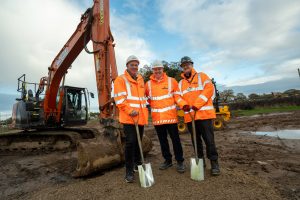Levelling Up and Regeneration Act 2023
The Levelling Up and Regeneration Act (LURA) became law in 2023. The legislation was introduced to tackle housing and planning challenges.
A government press release announced the Levelling-up and Regeneration Bill as coming into law to “speed up the planning system, hold developers to account, cut bureaucracy, and encourage more councils to put in place plans to enable the building of new homes.”
LURA targets reducing regional inequalities by supporting regeneration in ‘left-behind communities’. The vision was for new homes to be built to higher standards alongside vital infrastructure such as GP surgeries, schools and transport links to revitalise high streets and town centres.
Since the Act became law, planning policy has continued to evolve, with some of the Levelling Up and Regeneration Bill’s reforms now in force, others still pending, and new government priorities shaping how they will be applied in practice.
In this guide, we explore the current and future implications of the Levelling Up and Regeneration Act 2023 for developers, planners, local authorities and contractors, covering the following key areas:
- What the Levelling Up and Regeneration Act set out to do
- What the Act means today
- How LURA tackles regional priorities
- Which parts of the Act have already been implemented
- What is still to come
- Why the Levelling Up and Regeneration Act matters
- Why comprehensive preparation is key
What the Levelling Up and Regeneration Act set out to do
The Levelling Up and Regeneration Act 2023 set out a range of enabling powers that directly impact developers, planners, local authorities, contractors and communities as follows:
Streamline planning
Local plans will be prepared more quickly through enhanced digitisation, tighter deadlines, increased local empowerment and simplified environmental assessments.
The creation of new National Development Management Policies (NDMPs) prevents local planners from having to repeat nationally important policies in their own plans. This speeds up the process of producing local plans, with a focus on locally relevant policies.
Funding infrastructure
The Levelling Up and Regeneration Bill includes the introduction of the Infrastructure Levy (IL) to gradually replace the Community Infrastructure Levy (CIL) and many Section 106 agreements (S106).
While CIL will remain in Greater London and Wales, the Infrastructure Levy is a planning charge that allows all other local authorities to fund local infrastructure such as schools, surgeries, open spaces and transport alongside affordable housing, and to capture uplifts in land value more effectively. The Infrastructure Levy was introduced to create a mandatory, locally determined contribution by developers.
Environmental reforms
Environmental reforms under the Levelling Up and Regeneration Act 2023 include the introduction of Environmental Outcomes Reports (EORs) to modernise the EU-derived system of Environmental Impact Assessments (EIAs) and Strategic Environmental Assessments (SEAs).
The new streamlined system helps the government to realise its environmental ambitions directly through the planning and decision-making processes on the largest developments.
Delivery focus
The Levelling Up and Regeneration Act introduces new powers to tackle slow housing build-out and ensure planning permissions result in new homes.
The Levelling Up and Regeneration Bill consultation outcome paper published in December 2023 acknowledged that only around 40% of local authorities had plans adopted during the previous five years. Under the Act, developers submit commencement notices which specify the date on which work will begin. They then notify local planning authorities when they commence development, and report annually on progress.
Council planners can also implement stronger enforcement measures to tackle rogue landowners who repeatedly break planning rules.
Community tools
The Levelling Up and Regeneration Bill empowers communities to shape their neighbourhoods by giving residents ‘street votes’ through which they can propose development on their own streets and, subject to certain requirements, vote on whether that development should be given planning permission.
Street votes facilitate better use of land in existing communities, optimise existing infrastructure, and reduce development pressure on green belt.
Compulsory purchase and regeneration
The Levelling Up and Regeneration Act 2023 updated Compulsory Purchase Order (CPO) rules to ignore ‘hope value’ in compensation assessments to speed up brownfield redevelopment and regeneration projects. Hope value refers to the extra worth attributed to land due to its prospects for future planning permission.
Instead, under the Levelling Up and Regeneration Bill, compensation calculations for CPOs can be assessed based on the value of the land under its existing use, if it had been sold on the open market.
It is important to note that many of the enabling powers listed above require further legislation and guidance before coming into effect.
The timeline of the Levelling Up and Regeneration Bill since Royal Assent
Since the Levelling Up and Regeneration Bill received Royal Assent on October 26th 2023, the Act has progressed as follows:
2023 – 24
Early updates were initiated. These included:
- Consultations on reforms to the National Planning Policy Framework (NPPF) to prioritise building on brownfield sites, such as:
- mandatory housing targets
- the introduction of a grey belt land category for green belt release
- a two-step Standard Method for assessing housing needs.
- Guidance around new plan-making requirements which included a 30-month local plan timetable, including gateway checks and consultation requirements. This roughly halves the amount of time plans were taking.
The Act sets the legal basis for the new system. Not all plan-making provisions are yet in force.
2024 – 25
- The NPPF was updated in February 2025 to reflect LURA-related reforms
- NDMPs were flagged as forthcoming but have not yet been published. Further consultation is expected
- EORs were legally enabled but, as of Autumn 2025, have not yet come into force. Therefore, the existing EIAs and SEAs still apply
- The Infrastructure Levy framework exists in law, but regulations and local rollout are still pending, meaning CIL and Section 106 continue in the meantime
- Build-out measures have given local councils more tools to monitor and enforce against slow housing delivery.
2025 and beyond
The Labour government’s regeneration and housing programme builds on the new powers outlined above. In July 2025 the government set out its 10 year plan to build more social and affordable homes including council properties, and revolutionise social rent through a new £39 billion Social and Affordable Homes Programme.
Local authorities have been empowered by the Levelling Up and Regeneration Bill to speed up development in areas identified as new regeneration zones to reduce geographic disparities for improved living standards.
Some of the Act’s reforms awaiting secondary legislation and regulations before full implementation include:
- EORs to replace EIAs. The timeline for this is unclear
- The Infrastructure Levy will be rolled out upon completion of a ‘test and learn’ process, with no specific timeline agreed
- NDMPs consultations will continue, with their introduction expected to be closely linked to the new local plan system
- Following secondary legislation, the new 30-month local plan-making system is expected to begin by the end of 2025, with plan submissions under the current system complete by December 2026
- Powers to deal with slow build-out rates are awaiting regulatory approval.
A summary of the current state of play of the Levelling Up and Regeneration Act 2023
- Some reforms are already active. These include updates to the NPPF and the new build-out powers
- Some reforms exist in law but are not yet live. These include the Infrastructure Levy, NDMPs and EORs
- The planning system is in transition. It is essential that developers, planners and councils keep track of when each reform will be implemented to ensure they are sufficiently prepared.
Why the Levelling Up and Regeneration Act still matters
Despite a change in government and transition in political discourse, the Levelling Up and Regeneration Act remains central to planning reform. By providing a legal framework for speeding up development, building more homes, improving infrastructure and decentralising planning decisions, the Act simplifies the planning system to the benefit of communities, developers, local authorities and planners.
A comprehensive understanding of the Levelling Up and Regeneration Bill is critical for developers and planners to prepare for transition risks. Changes implemented through the Infrastructure Levy, EORs and NDMPs all present potential stumbling blocks if adequate preparation is not applied.
Local authorities have new responsibilities under the Act which include:
- defining the scope of the plan
- preparing a programme for how the local plan will be developed, including when the public will be consulted
- preparing a vision for how the area could change and develop
- outlining how these changes will be delivered and monitored
- preparing evidence to test the plan for transparency
- inviting early participation and holding consultations with local communities, stakeholders and statutory bodies throughout the process
- ensuring the plan seizes opportunities for protecting the environment and human health
- having the plan assessed by a Planning Inspector at public examination, which should take no longer than six months
- monitoring plan delivery.
For contractors and other businesses involved in planning, staying ahead of the Act’s reforms minimises project risk and contributes to improving delivery certainty.
The Levelling Up and Regeneration Act 2023: Key Takeaways
The impact of LURA on planning cannot be overstated. The Levelling Up and Regeneration Act 2023 remains the backbone of ongoing planning reform.
For developers, planners, local authorities and contractors, being vigilant and fully aware that the Act is an unfolding story, is crucial. All stakeholders should
- carefully monitor all updates
- engage in consultations to fully understand proposals and have your say
- prepare for staged changes to avoid unnecessary pitfalls
Keep updated with Procure Partnerships Framework
At Procure Partnerships Framework we’ll continue to track planning reforms closely. For further updates, check our latest articles and resources. To discuss what these changes specifically mean for your business, get in touch.
Definitions
LURA – The Levelling Up and Regeneration Act 2023
NDMPs – National Development Management Policies
IL – Infrastructure Levy
CIL – Community Infrastructure Levy
S106 – Section 106 agreements
EORs – Environmental Outcomes Reports
EIAs – Environmental Impact Assessments
SEAs – Strategic Environmental Assessments
CPO – Compulsory Purchase Orders
NPPF – National Planning Policy Framework



